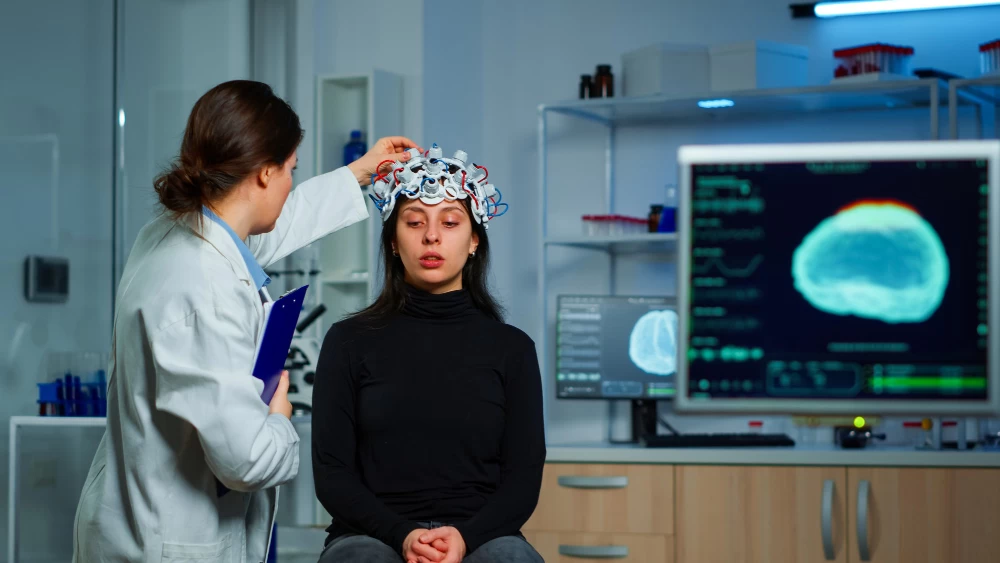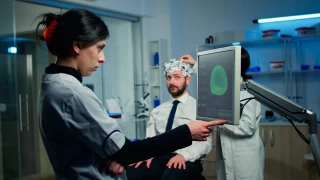
What is Neuronavigation?
- What is Neuronavigation?
- In Which Diseases Is Neuronavigation Used?
- What are the Distinctive Features of the Neuronavigation System?
- How Does the Neuronavigation Process Occur?
- What are the Points to Be Considered After the Neuronavigation Procedure?
Neuronavigation refers to the use of advanced imaging techniques such as MRI (Magnetic Resonance Imaging) or CT (Computed Tomography) scans to guide surgical interventions in the brain or spine. It is a computer-assisted technology that allows neurosurgeons to accurately navigate complex anatomical structures in the brain or spine, avoiding critical areas such as blood vessels, nerves, and functional areas of the brain during surgery.
The process typically involves taking high resolution 3D images of the patient's brain or spine and then uploading them to a computer system. The system uses advanced software to create a virtual 3D map of the brain that is superimposed on the patient's actual anatomy during surgery. This enables the neurosurgeon to visualize the target area and surrounding structures in real time, providing enhanced precision and accuracy during the procedure.
Neuronavigation is widely used in a variety of neurosurgical procedures, including removal of brain tumors, deep brain stimulation, and placement of electrodes for seizure management. It has dramatically improved the safety and effectiveness of neurosurgical interventions, enabling neurosurgeons to perform procedures that were once thought to be too risky or difficult to try.
In Which Diseases Is Neuronavigation Used?
- Brain tumors: Neuronavigation can be used to precisely detect and remove brain tumors while minimizing damage to healthy brain tissue.
- Epilepsy: Neuronavigation can be used.
- Vascular malformations: Neuronavigation can be used to find and surgically treat vascular malformations in the brain such as arteriovenous malformations.
- Movement disorders: Neuronavigation can be used to target specific areas of the brain for deep brain stimulation to treat movement disorders such as Parkinson's disease.
- Traumatic brain injury: Neuronavigation can be used to guide surgical procedures in patients with traumatic brain injury, such as removing a blood clot or repairing a skull fracture.
Overall, neuronavigation is a valuable tool in neurosurgery and allows for more precise and safer surgical interventions in various brain disorders.
What are the Distinctive Features of the Neuronavigation System?
The neuronavigation system is a technology that allows neurosurgeons to precisely detect and target brain structures during surgery.
Here are some distinctive features of the neuronavigation system:
- Real-time imaging: The neuronavigation system uses real-time imaging to provide high-resolution images of the brain. This allows neurosurgeons to see the exact position and orientation of the surgical instrument relative to the brain structures.
- Image-guided surgery: The neuronavigation system allows for image-guided surgery, which involves placing pre-operative imaging (such as MRI or CT scans) into the patient's anatomy during surgery. This allows the surgeon to precisely target the area of interest and avoid damaging adjacent healthy tissue.
- 3D visualization: The neuronavigation system provides 3D visualization of brain structures, improving the surgeon's understanding of anatomy and helping to identify critical structures to avoid during surgery.
- Improved accuracy: the neuronavigation system increases the accuracy of surgical procedures, reducing the risk of complications and improving patient outcomes.
- Surgical planning: Neuronavigation system allows surgeons to plan and simulate surgical procedures before actual surgery. This helps optimize the surgical approach and minimize the risk of complications.
- Integration with other technologies: The neuronavigation system integrates with other technologies such as intraoperative MRI and ultrasound, providing real-time monitoring of the surgical procedure and increasing the accuracy of targeting.
Overall, the neuronavigation system is a powerful tool that helps neurosurgeons perform precise and safe surgeries with improved outcomes for patients.

How Does the Neuronavigation Process Occur?
Neuronavigation is a neurosurgical technique that involves using advanced imaging technologies such as magnetic resonance imaging (MRI) and computed tomography (CT) scans to create three-dimensional (3D) maps of a patient's brain. These maps are then used to guide surgical instruments to specific locations in the brain with high precision.
The neuronavigation process typically includes the following steps:
- Image acquisition: The first step is to obtain high resolution MRI or CT scans of the patient's brain. These scans are used to create a 3D map of the brain using special software.
- Image registration: The 3D map is then saved or aligned to the patient's head in the operating room using reliable markers or surface mapping techniques. This step ensures that the map accurately reflects the patient's anatomy.
- Surgical planning: Once the 3D map is saved, the surgeon can use it to plan the surgical approach and determine the optimal trajectory to reach the target area in the brain. This may include identifying critical structures to be avoided, such as blood vessels or areas of functional importance.
- Intraoperative guidance: During surgery, a 3D map is placed on the patient's head using a tracking system that monitors the position and orientation of surgical instruments in real time. This allows the surgeon to navigate the target area with precision while avoiding damage to critical structures.
Overall, neuronavigation helps improve the accuracy and safety of neurosurgical procedures by providing real-time guidance based on a detailed understanding of the patient's individual anatomy.
What are the Points to Be Considered After the Neuronavigation Procedure?
Neuronavigation is a medical technique used to precisely guide surgical instruments or radiation therapy devices to a specific location in the brain. After the neuronavigation procedure, there are several things to consider to ensure a safe and successful recovery.
These may include:
- Monitoring of vital signs: It is important to monitor vital signs of the patient such as blood pressure, heart rate and respiratory rate after the procedure. Any abnormality should be reported to the healthcare professional immediately.
- Pain management: Patients may experience pain or discomfort after the procedure and appropriate pain management strategies should be used to reduce discomfort. This may include medications or other non-pharmacological interventions.
- Infection prevention: Neuronavigation procedures can increase the risk of infection, so it is important to follow proper infection prevention protocols, such as keeping the surgical site clean and dry.
- Follow-up appointments: Patients should come to follow-up appointments to monitor their progress and address any concerns or complications that may arise.
- Rehabilitation: Depending on the nature of the procedure, patients may need rehabilitation to regain any lost function. Rehabilitation may include physical therapy, occupational therapy, or speech therapy.
- Lifestyle changes: To ensure successful recovery, patients may need to make lifestyle changes after the procedure, such as avoiding certain activities or foods.
It is important for patients to discuss any concerns or questions with their healthcare provider to ensure a safe and successful recovery after the neuronavigation procedure.




